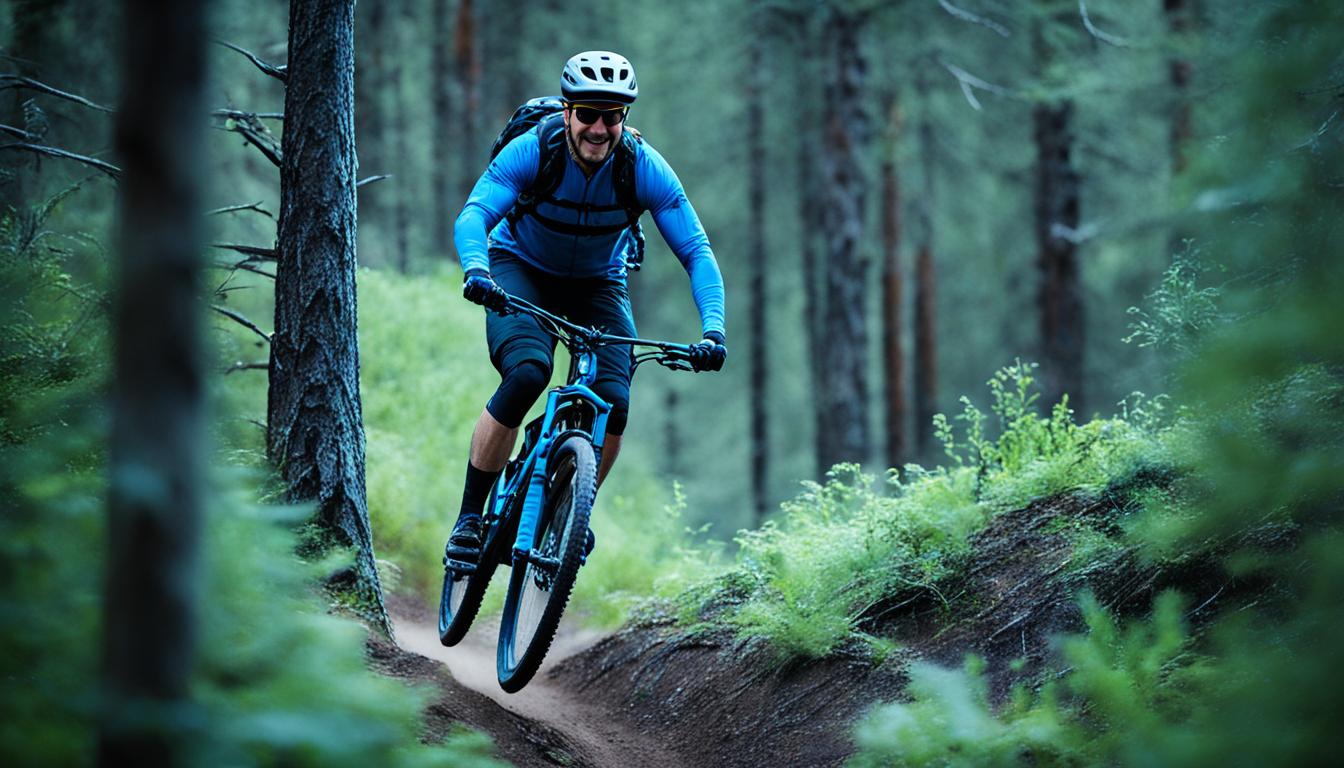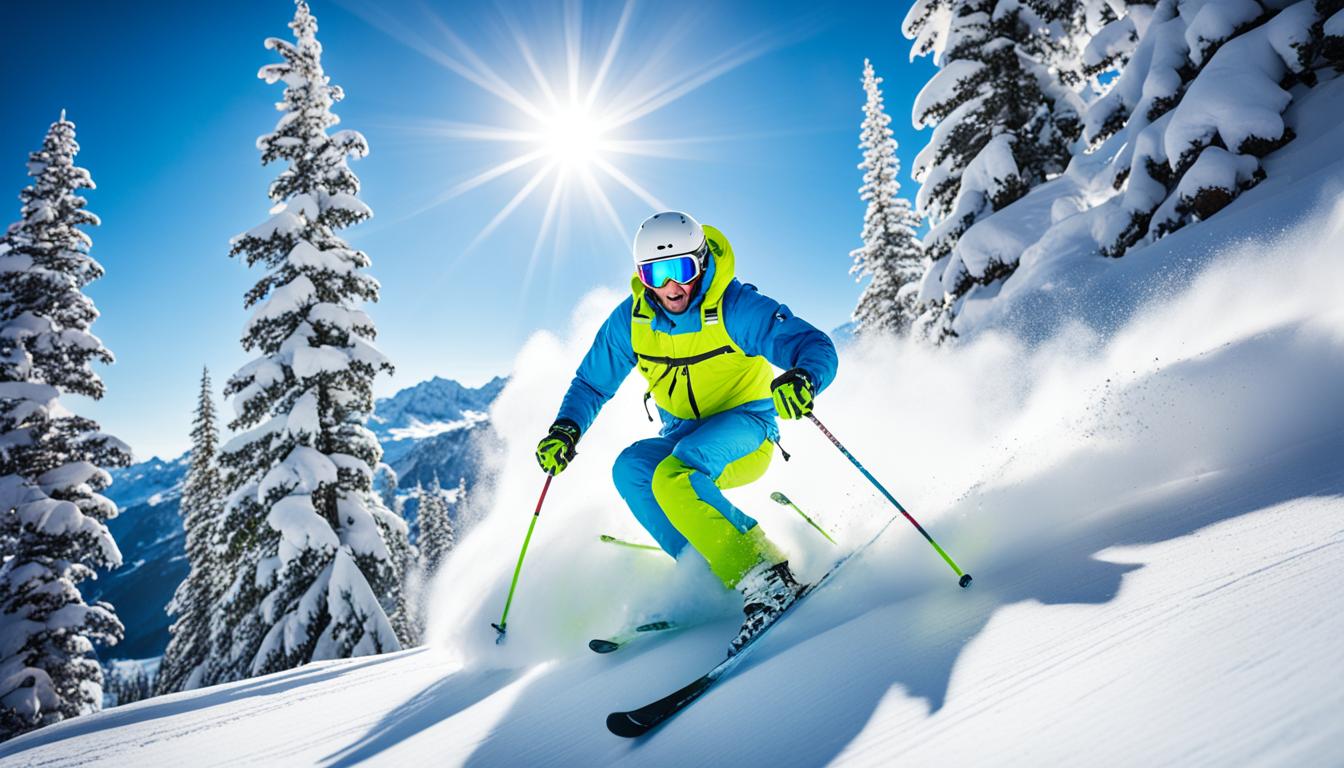Welcome to our guide on progressing from green to blue trails in mountain biking. Transitioning from beginner-level to intermediate-level trails is an exciting milestone that allows you to test your skills and explore new challenges. In this article, we will provide you with expert tips and guidance to enhance your mountain biking skills and confidently tackle blue trails.
Before we dive into the details of progression, let’s gain a better understanding of the trail rating system. Green trails are perfect for beginners, while blue trails offer a more intermediate level of difficulty. Blue trails typically feature steeper sections, additional obstacles, and tighter turns compared to their green counterparts. Familiarizing yourself with the trail rating system will help you gauge your skill level and determine if you are ready to take on the challenges of blue trails.
Key Takeaways:
- Transitioning from green to blue trails is an exciting milestone for mountain bikers.
- Understanding the trail rating system is crucial to assess your skill level.
- Green trails serve as a foundation for developing mountain biking skills.
- Building confidence is essential before tackling blue trails.
- Transitioning to blue trails requires a strategic and gradual approach.
Understanding the Trail Rating System
Before venturing onto blue trails, it’s important to understand the trail rating system. Green trails are considered beginner-level, while blue trails are intermediate-level. Blue trails generally have steeper sections, more obstacles, and tighter turns compared to green trails. Familiarize yourself with the trail difficulty levels and assess your skill level to determine if you’re ready to progress to blue trails.
Mastering Green Trail Progression
To progress to blue trails, it’s essential to master green trail techniques and build a solid foundation of mountain biking skills. Spending ample time riding green trails will allow you to improve your bike handling, balance, and control, ultimately preparing you for the challenges of riding blue trails.
One of the key aspects of green trail progression is practicing cornering. Learning how to navigate turns with precision and fluidity is crucial for maintaining speed and control on the trail. Focus on leaning your bike and body into the turn while keeping your eyes on the exit point to maintain a smooth and efficient line.
“Cornering is an essential skill that not only improves your overall performance but also enhances your confidence on challenging trails,” says Mike Davies, a professional mountain biker and coach.
“By practicing cornering on green trails, you’ll develop the necessary skills to negotiate tight turns with ease and tackle the more technical sections of blue trails.”
Another skill to focus on is braking. Proper braking technique is essential for maintaining control and speed modulation on the trails. It’s important to become comfortable with both front and rear braking, finding the right balance to avoid skidding or losing control.
Additionally, navigating obstacles is a crucial aspect of green trail progression. Develop the ability to confidently maneuver over rocks, roots, and other trail features. Practice lifting your front wheel to clear obstacles and using your body positioning to maintain balance throughout.
“Obstacle navigation is a fundamental skill that will serve you well on both green and blue trails,” advises Sarah Thompson, a seasoned mountain biker with years of experience.
“The more comfortable you become with navigating obstacles, the more confidence you’ll have when encountering technical sections on blue trails.”
By consistently practicing cornering, braking, and obstacle navigation on green trails, you’ll gradually build the skills and confidence necessary to conquer blue trails. Remember to set aside dedicated practice sessions to focus on these key techniques and monitor your progress over time.
| Skills to Master for Green Trail Progression | Benefits |
|---|---|
| Cornering | Improved speed, control, and confidence on turns |
| Braking | Enhanced control and speed modulation |
| Obstacle Navigation | Increased confidence in handling technical features |
Building Confidence on Blue Trails
Building confidence on blue trails requires a combination of skill development and mental preparation. We understand that taking the next step and transitioning from green to blue trails can be both thrilling and intimidating. But fear not, with the right approach and some practice, you’ll be tackling those blue trails with confidence!
So, where do you begin? It all starts with selecting the right blue trails that match your current skill level. It’s important not to jump into trails that are too advanced right away, as it may lead to frustration and hinder your progression. Instead, gradually increase the difficulty as you build your skills and confidence.
As you navigate these blue trails, remember to maintain a relaxed posture and keep your eyes focused on scanning the trail ahead. This will allow you to anticipate any obstacles or challenges that lie ahead. By looking further down the trail, you’ll have more time to react and choose the best lines.
Practice makes perfect, as they say. Spend time riding over small obstacles found on blue trails to enhance your bike handling skills and gain confidence in tackling technical features. Start with smaller jumps and drops, gradually increasing both your speed and the level of technicality you’re comfortable with.

Remember, building confidence on blue trails is all about pushing your boundaries at your own pace. What may seem daunting at first can turn into an exhilarating challenge that showcases your improving mountain biking skills. So, get out there, embrace the thrill, and conquer those blue trails!
Tips for Transitioning to Blue Trails
Transitioning from green to blue trails requires a strategic approach to ensure a smooth progression in your mountain biking journey. Here are some expert tips to help you confidently navigate the challenges of blue trails:
Incorporate Blue Trail Sections
Start by incorporating sections of blue trails into your rides on green trails. This gradual transition allows you to acclimate to the increased difficulty while still enjoying the familiarity of green trails. It’s a great way to build confidence and assess your readiness for full blue trail rides.
Identify and Improve Specific Skills
Identify the specific skills you need to work on to better navigate blue trails. Whether it’s improving your cornering technique or honing your bike handling skills, dedicating focused practice time on these areas will help you tackle the challenges of blue trails with more confidence.
Seek Guidance from Experienced Riders
Don’t be afraid to seek guidance from experienced riders who have already mastered blue trails. They can share valuable insights, tips, and techniques that can accelerate your progression and help you avoid common mistakes. Join a local mountain biking community or consider taking part in group rides to connect with knowledgeable riders.
Consider Skills Clinics
If you’re looking for a more structured approach to improving your mountain biking skills, consider enrolling in skills clinics or workshops. These sessions are led by certified instructors who can provide personalized guidance and teach you advanced techniques specific to blue trails. Skills clinics can greatly enhance your progression and give you the confidence to tackle more challenging trails.
Remember, transitioning to blue trails is a journey that requires patience, practice, and perseverance. Celebrate every small victory and enjoy the process of improving your skills. With the right mindset and dedication, you’ll soon find yourself tackling blue trails with ease.
| Tips for Transitioning to Blue Trails | |
|---|---|
| Incorporate Blue Trail Sections | – Gradually transition from green to blue trails by integrating blue trail sections into your rides on green trails. |
| Identify and Improve Specific Skills | – Identify the specific skills you need to work on, and dedicate focused practice time to improve them. |
| Seek Guidance from Experienced Riders | – Connect with experienced riders who can provide valuable insights and tips for navigating blue trails. |
| Consider Skills Clinics | – Join skills clinics or workshops led by certified instructors to gain personalized guidance and learn advanced techniques. |
Pushing Your Limits and Overcoming Challenges
As you gain confidence and experience on blue trails, it’s important to continually push your limits and seek new challenges. Experimenting with different lines and techniques will help you improve your mountain biking skills and progress to the next level.
Gradually Increase the Speed and Difficulty
One of the key ways to improve your mountain biking skills is by gradually increasing the speed and difficulty of your rides. Start by exploring blue trails with gentle slopes and obstacles. As you become more comfortable, tackle trails with steeper sections and bigger challenges. Pushing yourself in increments allows you to build confidence and skill without overwhelming yourself.
Embrace Falls as Learning Opportunities
Mountain biking involves risks, and it’s normal to experience occasional falls or setbacks. Instead of getting discouraged, embrace these moments as valuable learning opportunities. Analyze what went wrong, adjust your technique, and try again. It’s through these challenges that you’ll grow as a rider and improve your skills.
“Success is not final, failure is not fatal: It is the courage to continue that counts.” – Winston Churchill

Stay Committed to Your Progression Journey
Improving your mountain biking skills takes time and dedication. Stay committed to your progression journey by setting goals and consistently challenging yourself. Surround yourself with like-minded riders who inspire and support you. Celebrate every milestone reached and keep pushing forward to achieve your full potential.
Continual Progression through Challenges
The mountain biking community is built on a culture of progression and overcoming challenges. As you push your limits on blue trails, remember that each obstacle you conquer is a victory in itself. Approach new challenges with determination and a growth mindset, and you’ll see continuous improvement in your mountain biking skills.
| Mountain Biking Progression Tips |
|---|
| Gradually increase the speed and difficulty of your rides |
| Embrace falls as learning opportunities |
| Stay committed to your progression journey |
| Continually challenge yourself and set goals |
| Approach new challenges with a growth mindset |
Exploring Advanced Techniques and Trails
Once you’ve mastered the blue trails, it’s time to take your mountain biking skills to the next level. Exploring advanced techniques and trails will challenge you both mentally and physically, and open up a whole new world of excitement and adventure. Here are some tips to help you continue improving your mountain biking skills and progress as a rider:
1. Learn Jumping and Dropping
One of the most thrilling aspects of advanced mountain biking is learning how to jump and drop with style and confidence. Jumping allows you to fly through the air and clear obstacles with ease, while dropping involves smoothly navigating steep descents. To master these techniques, start with small jumps and drops and gradually work your way up to bigger ones. Focus on proper body positioning, timing, and landing techniques to ensure a smooth and controlled ride.
2. Conquer Technical Features
Technical features such as rock gardens, root sections, and off-camber trails add excitement and challenge to your rides. To conquer these features, practice maintaining a stable and balanced body position, using your bike’s suspension to your advantage, and choosing the best line to navigate through obstacles. Start with sections of the trail that have technical features and gradually increase the difficulty as you become more confident.
3. Seek Professional Guidance
If you’re looking to progress quickly and efficiently, consider taking advanced skills clinics or hiring a mountain biking coach. These experts can provide personalized guidance, help you refine your technique, and offer valuable insights to overcome challenging trails and obstacles. They can also provide valuable safety tips and help prevent injuries as you push your limits.
Remember, exploring advanced techniques and trails requires dedication, practice, and a mindset of continuous improvement. Always ride within your skill level and progressively challenge yourself to reach new heights. The more you push your limits, the more you’ll grow as a mountain biker and the more rewarding your rides will become.
Conclusion
Progressing from green to blue trails is an exhilarating journey that allows you to take your mountain biking skills to the next level. By understanding the trail rating system, mastering green trail progression, building confidence, and pushing your limits, you can successfully transition to blue trails and continue your progression as a mountain biker.
Understanding the trail rating system is crucial in determining your readiness to tackle blue trails. Take the time to familiarize yourself with the trail difficulty levels and assess your skill level honestly. This self-awareness will ensure you choose trails that challenge you without being overwhelming.
Mastering green trail progression is essential to building a strong foundation of mountain biking skills. Spend ample time honing your bike handling, balance, and control on green trails. Practice cornering, braking, and navigating obstacles to enhance your confidence and prepare yourself for the challenges that blue trails present.
Remember, progression is a journey, and it’s important to ride within your skill level and seek guidance when needed. As you gain experience and confidence, gradually push your limits and embrace new challenges. Always prioritize safety and enjoy every moment of the ride. Happy trail progression!
FAQ
What are green trails?
Green trails are considered beginner-level trails in mountain biking. They have easier terrain and fewer obstacles compared to more intermediate or advanced trails.
What are blue trails?
Blue trails are intermediate-level trails in mountain biking. They are slightly more challenging than green trails and may have steeper sections, more obstacles, and tighter turns.
How do I progress from green to blue trails?
To progress from green to blue trails, focus on mastering green trail techniques and building a solid foundation of mountain biking skills. Practice bike handling, balance, and control, and gradually increase the difficulty of the trails you ride. Seek guidance from experienced riders or consider taking a skills clinic to accelerate your progression.
How do I build confidence on blue trails?
Building confidence on blue trails requires a combination of skill development and mental preparation. Choose blue trails that match your skill level and gradually increase the difficulty as you progress. Practice maintaining a relaxed posture, scanning the trail ahead, and choosing the best lines. Start by riding over small obstacles and gradually increase your speed and level of technicality.
What tips can you provide for transitioning to blue trails?
When transitioning to blue trails, incorporate sections of blue trails into your rides on green trails to gradually acclimate to the increased difficulty. Identify specific skills you want to improve and practice them on blue trail sections. Seek guidance from experienced riders or consider taking a skills clinic to accelerate your progression.
How can I push my limits and overcome challenges while progressing?
To push your limits and overcome challenges, experiment with different lines and techniques on the trails. Gradually increase the speed and difficulty of your rides. Embrace falls or setbacks as learning opportunities and stay committed to your progression journey.
What should I do after mastering blue trails?
After mastering blue trails, you can start exploring more advanced techniques and trails. This may include learning jumps, drops, and more technical features. Consider taking advanced skills clinics or hiring a mountain biking coach to further refine your technique and expand your trail repertoire.




